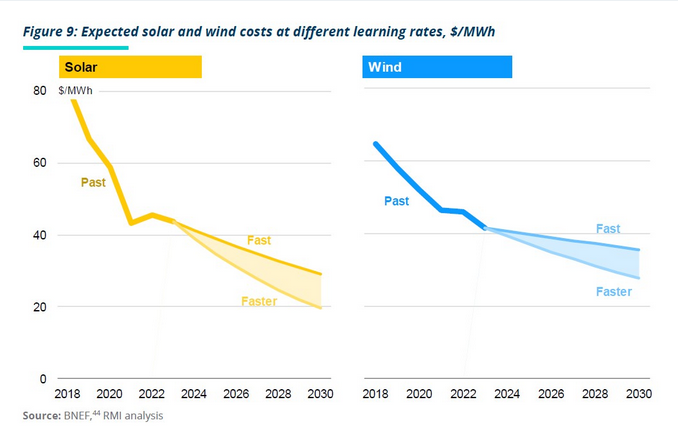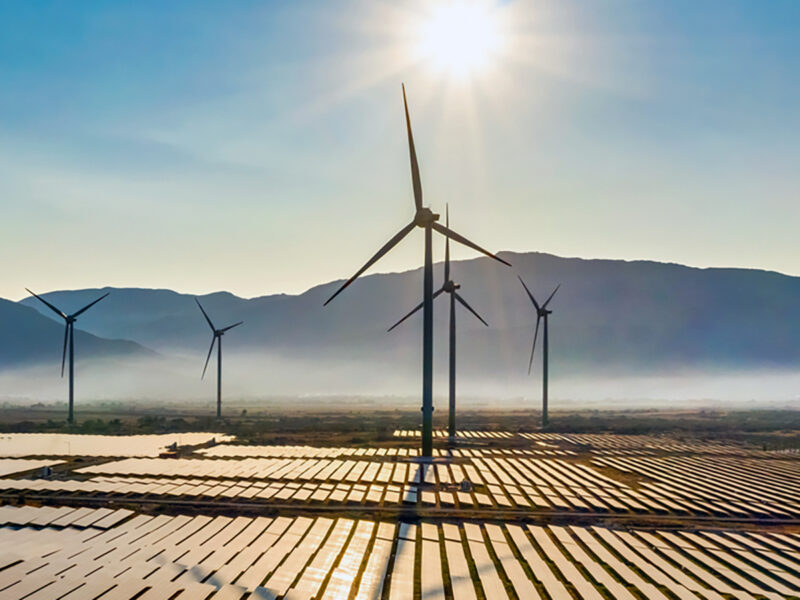Rapid growth in the deployment of solar, wind and battery power means that, by 2030, the global electricity system can deliver ambitious net-zero trajectories, according to a new RMI study conducted in collaboration with the Bezos Earth Fund.
This exponential growth in renewable electricity is generating wide-ranging benefits, such as security of supply and job growth, as well as offsetting energy price inflation.
By 2030, RMI forecasts that solar and wind power will supply more than one-third of all global electricity, up from 12% today. Solar and wind power are forecast to generate between 12,000 and 14,000 terawatt hours (TWh) in 2030, or 3 to 4 times more than in 2022. It would also exceed recent calls up to COP28 to triple total renewable energy capacity by 2030.
Meanwhile, according to RMI’s analysis, demand for electricity from fossil fuels will experience a sharp decline, by as much as 30% from the 2022 peak to 2030, as renewable electricity will continue to outpace hydrocarbons in cost.
Some key countries and regions, such as China and Europe, are leading the adoption of clean energy technologies, at an exponential growth rate. However, the deployment of renewables is also increasingly distributed around the world, including the Middle East and Africa, which are rapidly catching up and taking advantage of the global growth trend.
Uruguay, Denmark, Lithuania, Namibia, the Netherlands, Palestine, Jordan and Chile have already increased solar and wind generation at high speed, demonstrating that a rapid transition can be achieved in many different contexts.
Globally, wind and solar must increase from 12% to 41% by 2030, an increase of 29 percentage points. Denmark, Uruguay and Lithuania have already achieved such an increase over a comparable eight-year period. Namibia, the Netherlands, Palestine, Jordan and Chile have increased solar and wind generation at a sufficient rate over five years.
These countries have increased wind and solar under very different circumstances. They span both developing and developed countries, with GDP per capita ranging from $4,000 to $67,000 per year. These countries were driven to accelerate renewables by a variety of factors, including adopting smart and effective policies, maintaining political commitment, reducing renewable energy costs and improving energy security.
“The exponential growth trend in renewable electricity can be leveraged to help developing countries get ahead of the curve and transition more quickly to a cleaner, more affordable electricity system,” said Andrew Steer, President and CEO of the Bezos Earth Fund.
Exponential deployment rates are driving down renewable energy prices at an unprecedented rate, making more expensive hydrocarbons uncompetitive in most markets.
According to RMI’s forecasts, the cheapest electricity in history will be halved again by 2030, to $20/MWh for solar, compared to more than $40/MWh today.
The cost of renewable electricity has plummeted over the past 10 years, overcoming a key barrier to widespread deployment. Solar and battery costs have fallen 80% between 2012 and 2022, while offshore wind costs have dropped 73% and onshore wind 57%, BNEF data show.
“The exponential growth of clean energy is an unstoppable force that will put more purchasing power in consumers’ pockets. The benefits of rapid deployment of renewables are greater energy security and independence, as well as long-term energy price deflation, as it is a manufactured technology: the more you install, the cheaper it gets,” said Kingsmill Bond, Director of RMI.
(https://elperiodicodelaenergia.com/la-eolica-y-la-solar-produciran-mas-de-un-tercio-de-la-energia-mundial-en-2030/)



